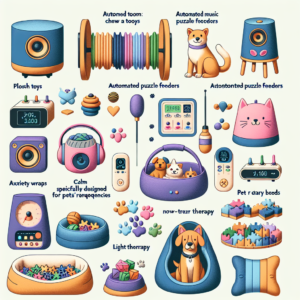- Key Takeaways
- Highlights of Wearable Technology for Pain Relief
- Types of Wearables Suitable for Senior Pets
- Selecting the Right Device for Your Pet
- Common Causes of Discomfort in Older Pets
- Signs Your Senior Pet Might Be in Pain
- Risks Associated with Common Pet Painkillers
- Side Effects That May Affect Your Pet's Quality of Life
- The Science Behind Wearable Pain Relief
- Wearable Technology and Pet Mobility Improvement
- Real-Life Success Stories
- Evaluating Your Pet's Needs and Lifestyle
- Compatibility Considerations for Wearable Devices
- Emerging Technologies on the Horizon
- Integrating Wearables with Veterinary Care
- How Do Wearable Innovations Differ from Traditional Pain Management?
- Can Wearables Replace Veterinary Care for Chronic Pain?
- Are There Any Risks Involved in Using Wearable Pain Relief Devices?
- How Do You Introduce a Senior Pet to Wearable Technology?
- Where Can Pet Owners Find These Innovative Wearable Devices?

Key Takeaways
- Understanding the signs of pain in senior pets is crucial for their well-being.
- Wearable pain relief devices offer a drug-free alternative to traditional pain medications.
- Choosing the right wearable technology depends on your pet’s specific needs and condition.
- Smart collars, therapeutic wraps, and supportive vests are examples of innovative wearables for pets.
- These devices can improve your senior pet’s quality of life by enhancing mobility and reducing discomfort.
Comforting Mature Companions: Wearable Innovations for Senior Pets
As our beloved pets age, they often face challenges that weren’t present in their younger years. One of the most pressing issues for senior pets is managing pain, which can stem from a variety of sources such as arthritis, hip dysplasia, or general wear and tear on the joints. While traditional medications have their place, there’s a growing interest in drug-free solutions that can provide relief without the side effects.
Highlights of Wearable Technology for Pain Relief
Wearable technology for pets is a groundbreaking approach to pain management that can make a significant difference in the lives of our senior companions. These devices are designed to be non-invasive and to provide continuous, localized pain relief directly to the areas where your pet needs it most. They can also help in monitoring their health and activity levels, ensuring that you’re informed about their well-being in real-time.
Types of Wearables Suitable for Senior Pets
There’s a variety of wearable devices that can aid in managing your senior pet’s pain. Here’s a quick rundown:
- Smart Collars: These collars can track activity levels and behaviors that indicate discomfort or pain, allowing for timely interventions.
- Therapeutic Wraps: Designed to provide targeted compression and support to aching joints and muscles.
- Supportive Vests: These can offer stability to pets with back or hip issues, improving their mobility and comfort.
Selecting the Right Device for Your Pet
When choosing a wearable device for your pet, consider their specific pain points and mobility issues. For example, a pet with arthritis in the hips might benefit most from a supportive vest, while one with general body aches could find relief with a therapeutic wrap.

Understanding the Pain in Our Aging Pets
It’s heartbreaking to see a pet in pain, especially when they can’t tell us what’s wrong. As a responsible pet owner, it’s important to recognize the signs that your furry friend might be suffering. These can include a decrease in activity, difficulty standing up or lying down, limping, or a change in their appetite or behavior.
Common Causes of Discomfort in Older Pets
Several conditions can cause pain in senior pets, with the most common being:
- Osteoarthritis
- Hip dysplasia
- Intervertebral disc disease (IVDD)
- Chronic joint inflammation
Signs Your Senior Pet Might Be in Pain
Keep an eye out for these tell-tale signs:
- Lethargy or decreased interest in play
- Whimpering or vocalizing when moving
- Reluctance to climb stairs or jump
- Excessive licking of a particular area
When you notice any of these symptoms, it’s time to consider pain management strategies that can improve your pet’s quality of life.
Why Avoid Traditional Pain Medications?
While traditional pain medications can be effective, they often come with risks, especially for long-term use in senior pets. These can include gastrointestinal issues, liver or kidney damage, and other potential side effects that may compromise their health further.
Risks Associated with Common Pet Painkillers
Common medications like NSAIDs can cause:
- Stomach ulcers
- Liver or kidney problems
- Changes in blood clotting
Side Effects That May Affect Your Pet’s Quality of Life
Besides physical side effects, medications can also affect your pet’s mood and energy levels, making them less interactive and possibly affecting their overall happiness.

Introducing Innovative Pain Relief Wearables
Let’s dive into some of the wearable innovations that are changing the game for pain relief in senior pets. These devices are not only effective but also prioritize your pet’s comfort and ongoing health.
Smart collars are an excellent way to keep a virtual eye on your pet’s activity. They can detect changes in behavior that may signal pain, such as restlessness or a decrease in movement. This information can help you and your vet make informed decisions about your pet’s pain management plan.
Therapeutic wraps are another fantastic innovation. They use compression to increase blood flow to sore muscles and joints, providing natural pain relief and reducing inflammation. These wraps can be especially helpful for pets with arthritis or muscle strains.
Supportive vests work by stabilizing the torso, which is particularly beneficial for pets with back pain or IVDD. By supporting the spine, these vests can alleviate pain and improve mobility.
These wearables are not only practical but also designed with your pet’s comfort in mind. They’re made from soft, breathable materials that won’t irritate your pet’s skin and are adjustable to ensure a perfect fit.
How Wearables Offer a Better Life for Your Aging Companion
It’s not just about pain relief; it’s about restoring the joy of life to our senior pets. Wearables provide a non-pharmacological approach that can lead to a happier, more active lifestyle for your furry family members.
With the support of wearables, your pet can enjoy their golden years with less pain and more play.
Most importantly, wearables can be a constant source of comfort. Imagine a gentle hug that’s always there, soothing your pet’s aches whenever they need it. That’s the kind of continuous care wearable pain relief options aim to provide.
For example, a smart collar might alert you if your pet is less active than usual, which could be an early sign of discomfort. By catching these changes quickly, you can adjust their care plan on the fly, ensuring they stay comfortable and content.

The Science Behind Wearable Pain Relief
Let’s talk about how these wearables work. The science is fascinating and quite simple: by applying gentle pressure, increasing circulation, or providing stabilizing support, these devices can significantly reduce pain and inflammation. This, in turn, leads to improved mobility and a better quality of life.
Therapeutic wraps, for example, utilize the principles of compression therapy. By snugly wrapping around a painful joint or muscle, they enhance blood flow to the area, which speeds up the healing process and provides natural pain relief.
Wearable Technology and Pet Mobility Improvement
By improving comfort levels, wearables directly impact your pet’s mobility. A dog who might have been hesitant to climb stairs due to hip pain could find the confidence to do so with the support of a hip wrap or vest. This improved mobility is crucial for maintaining muscle strength and overall health in senior pets.
Furthermore, the data collected by smart wearables can help you understand your pet’s mobility patterns, giving insights into the best times of day for exercise and rest, or alerting you to any unusual behaviors that may require attention.
Real-Life Success Stories
Consider the story of Max, a 12-year-old Labrador with arthritis. His owners noticed he was struggling to get up in the mornings. After fitting Max with a therapeutic hip wrap, they saw a remarkable improvement in his mobility. Max was not only more willing to move around but also showed signs of being in less pain throughout the day.
Then there’s Bella, a senior cat with chronic back pain. Her owners introduced her to a supportive vest designed for felines, which provided gentle support to her spine. Bella went from spending most of her days lying down to actively engaging with her family and even playing with her favorite toys again.

Choosing the Best Wearable Pain Solution
Every pet is unique, and their pain relief needs are no exception. When selecting a wearable pain relief device, consider the specific needs of your pet. Think about where they experience pain, their level of activity, and what they seem most comfortable wearing.
Evaluating Your Pet’s Needs and Lifestyle
Start by observing your pet’s daily routine. Do they have difficulty with certain movements? Are there specific times of day when they seem more uncomfortable? Answers to these questions can guide you towards the right type of wearable.
Compatibility Considerations for Wearable Devices
It’s also essential to ensure the device is a good fit for your pet’s lifestyle. A device that’s too bulky or restrictive might not be suitable for a pet that still enjoys a good romp in the yard, whereas a more sedentary pet might benefit from something offering substantial support.
Remember, the goal is to enhance your pet’s comfort without adding any new stress. So, the perfect wearable should be something they barely notice wearing—except for the pain relief it brings, of course.
The Future of Senior Pet Care: Continuing Innovations
The landscape of senior pet care is constantly evolving, with new technologies emerging that promise to improve the lives of our aging companions. As we look to the future, we can anticipate even more sophisticated wearables that not only manage pain but also prevent it, offering a glimpse into a future where our pets live longer, healthier lives.
Emerging Technologies on the Horizon
Researchers are working tirelessly to develop new wearables that can do things like deliver medication transdermally or use gentle electrical stimulation to manage pain. These innovations have the potential to provide even more personalized and effective pain management solutions for senior pets.
Integrating Wearables with Veterinary Care
Wearable technology is set to become a staple in veterinary care, with devices being used not only by pet owners at home but also by veterinarians as part of a comprehensive pain management plan. The data collected by these wearables can offer invaluable insights into a pet’s health, allowing for more precise and timely interventions.

Frequently Asked Questions (FAQ)
As pet owners explore the benefits of wearable technology for their senior pets, they often have questions about how these devices work and their potential impact. Let’s address some of the most common queries.
How Do Wearable Innovations Differ from Traditional Pain Management?
Unlike traditional pain medications that can have systemic side effects, wearables target pain locally and non-pharmacologically. This means fewer side effects and a more holistic approach to managing your pet’s discomfort.
Can Wearables Replace Veterinary Care for Chronic Pain?
While wearables offer significant benefits, they should be used in conjunction with veterinary care, not as a replacement. Veterinarians can help you devise a pain management plan that may include wearables as one of several strategies.
Are There Any Risks Involved in Using Wearable Pain Relief Devices?
When used correctly, the risks associated with wearable pain relief devices are minimal. However, it’s crucial to choose a device that’s well-suited to your pet’s needs and to monitor them for any signs of discomfort or skin irritation.
How Do You Introduce a Senior Pet to Wearable Technology?
Introducing a new device to your pet should be done gradually. Start by letting them inspect the wearable, then try it on for short periods while offering plenty of positive reinforcement. Gradually increase the duration as your pet becomes more comfortable.
Remember, patience is key. Your pet may take some time to adjust to the sensation of wearing a device, but with gentle encouragement, they’ll likely come to associate it with pain relief and improved mobility.
It’s also a good idea to keep an eye on your pet’s behavior and comfort level. If they seem distressed or the device is causing irritation, remove it immediately and consult with your vet for further guidance.
Where Can Pet Owners Find These Innovative Wearable Devices?
Finding the right wearable for your pet is easier than ever. Many devices are available online, at pet stores, or through your veterinarian. When selecting a device, look for one from a reputable manufacturer that specializes in pet health and offers customer support in case you have questions.
Additionally, attending pet health expos and talking to your vet can provide opportunities to learn about the latest devices and even try them out before making a purchase.
Ultimately, the best wearable for your pet is one that meets their specific needs, fits comfortably, and is backed by solid research and positive reviews from other pet owners. Don’t hesitate to reach out to your vet for recommendations based on your pet’s health history and current condition.
With the right wearable technology, your senior pet can enjoy a more comfortable, active, and happy life. And as a pet owner, you’ll have the peace of mind that comes from knowing you’re providing the best possible care for your furry family member in their golden years.
As pets age, they often suffer from discomfort and pain that can affect their quality of life. Fortunately, there are drug-free solutions available to help manage your senior pet’s pain, such as wearable technology designed specifically for animals. These innovative products can provide relief for your furry friends, ensuring their golden years are as comfortable as possible.



Leave a Reply